Bulgarian cuisine
| Part of a series on |
| Bulgarians българи |
|---|
 |
| Culture |
|
| By country |
| Subgroups |
| Religion |
| Language |
| Other |
|
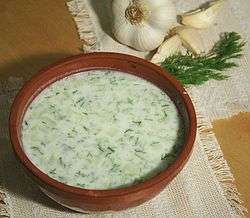

Bulgarian cuisine (Bulgarian: българска кухня, translit. bǎlgarska kuhnja) is a representative of the cuisine of Eastern Europe. It shares characteristics with other Balkans cuisines. Bulgarian cooking traditions are diverse because of geographical factors such as climatic conditions suitable for a variety of vegetables, herbs and fruit. Aside from the vast variety of local Bulgarian dishes, Bulgarian cuisine shares a number of dishes with Persian, Turkish, and Greek cuisine.
Bulgarian food often incorporates salads as appetizers and is also noted for the prominence of dairy products, wines and other alcoholic drinks such as rakia. The cuisine also features a variety of soups, such as the cold soup tarator, and pastries, such as the filo dough based banitsa, pita and the various types of börek.
Main courses are very typically water-based stews, either vegetarian or with lamb, goat meat, veal, chicken or pork. Deep-frying is not common, but grilling - especially different kinds of sausages - is very prominent. Pork is common, often mixed with veal or lamb, although fish and chicken are also widely used. While most cattle are bred for milk production rather than meat, veal is popular for grilling meats appetizers (meze) and in some main courses. As a substantial exporter of lamb, Bulgaria's own consumption is notable, especially in the spring.[1]
Similarly to other Balkan cultures the per capita consumption of yogurt (Bulgarian: кисело мляко, kiselo mlyako, lit. "sour milk") among Bulgarians is traditionally higher than the rest of Europe. The country is notable as the historical namesake for Lactobacillus bulgaricus, a microorganism chiefly responsible for the local variety of the dairy product.[2]
Bulgarian cuisine shares a number of dishes with the Middle Eastern Cuisine as well as a limited number with the Indian, particularly Gujarat cuisine. The culinary exchange with the East started as early as the 7th century, when traders started bringing herbs and spices to the First Bulgarian Empire from India and Persia via the Roman and later Byzantine empires.[3] This is evident from the wide popularity of dishes like moussaka, gyuvetch, kyufte and baklava, which are common in Middle Eastern cuisine today. White brine cheese called "sirene" (сирене), similar to feta, is also a popular ingredient used in salads and a variety of pastries.
Holidays are often observed in conjunction with certain meals. On Christmas Eve, for instance, tradition requires vegetarian stuffed peppers and cabbage leaf sarmi, New Year's Eve usually involves cabbage dishes, Nikulden (Day of St. Nicholas, December 6) fish (usually carp), while Gergyovden (Day of St. George, May 6) is typically celebrated with roast lamb.
Turkish influence
As in many areas of the Balkans that were formerly enslaved by the Ottoman Empire, food in Bulgaria is influenced by Turkish cuisine and Ottoman cuisine—ayran, baklava, gyuvech, and moussaka are all of Ottoman derivation.[4]
Traditional Bulgarian foods

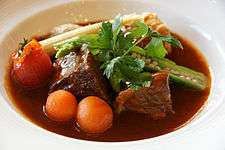
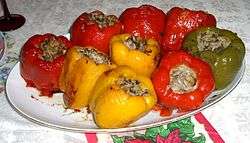
Bulgarian Breakfast
Cold cuts
- Banski starets (also banski staretz) — spicy sausage,[6] native to the Bansko region.[7]
- Elenski but — air-cured ham sausage, seasoned with herbs[6]
- Lukanka — spicy salami of minced beef and pork[5]
- Pastarma — spicy beef sausage;[8] a variant of Anatolian dried meat, called pastourmas to Greeks, bastirma in Azerbaijanis, and basterma to Arabs[9]
- Sujuk (also soudjouk, sukuk, sukuk, or sucuk) — flat cured, dark red sausage, common in the Balkans, Eastern Mediterranean, and North Africa[10][11]
Soups and stews
- Gyuvech — spicy vegetable stew, cooked in a clay pot[4]
- Supa ot kopriva (nettle soup)[12]
- Tarator — cold soup of cucumbers, garlic, yogurt and dill[5]
- Shkembe chorba — spicy soup made of tripe,[13] reputed in Bulgaria to be a "hangover cure"[14]
- Bob chorba — hot bean soup[15]
- Pacha — a sour lamb's-trotter soup," with sour ingredients such as pickles, bitter fruit, or vinegar in the broth[16]
- Zelenchukova supa — a vegetable-based soup[16]
- Gubena supa — forest mushroom soup[16]
- Ribena chorba — a fish soup made with thyme[17] and fresh lovage
Salads
- Ovcharska salata (shepherd's salad) — shopska salad, with the addition of grated egg, mushrooms, and sometimes ham.[18]
- Ruska salata — salad with potatoes, carrots, gherkins, and mayonnaise[18]
- Shopska salad — a common salad of chopped cucumbers, onions, peppers, and tomatoes with white cheese[19]
- Snezhanka ("Snow White salad") — chopped cucumbers with yogurt, walnuts, dill, garlic, and often walnuts[20]
- Turshiya (also torsi) — pickled vegetables, such as celery, beets, cauliflower, and cabbage, popular in wintertime; variations are selska turshiya (country pickle) and tsarska turshiya (king's pickles).[21]
Sauces, relishes, and appetizers
- Lyutenitsa (also lyutenitza) — purée of tomatoes, red peppers, and carrots, often served on bread and topped with white cheese[5]
- Kyopulu (also kyopolou) — roasted eggplant (aubergine) and bell peppers, mashed with parsley and garlic and other ingredients[22]
- Ljutika — spicy sauce
- Podluchen sauce or yogurt sauce — yogurt with garlic, oil, paprika, salt and sometimes dill.
- Katino meze—Hot starter with chopped pork meat, onion, mushrooms with fresh butter and spices.
- Drob po selski — chopped liver with onion and peppers
- Ezik v maslo — sliced tongue in butter
- Sirene pane — breaded Bulgarian brine white cheese bites
- Kashkaval pane — breaded kashkaval bites
- Mussels in butter — with onion and fresh herbs, traditionally from Sozopol
Skara (grill)

- Kyufte (meatballs of minced pork meat, seasoned with traditional spices and shaped in a flattened ball)
- Kebapche (similar to meatballs, but seasoned with cumin and shaped in a stick)
- Parjola (pork steak, chop or flank)
- Shishcheta (marinated pieces of chicken or pork and vegetables.)
- Karnache (a type of sausage with special spices)
- Nadenitsa (a type of sausage with special spices)
- Tatarsko kyufte (stuffed meatballs)
- Nevrozno kyufte (very piquant meatballs)
- Chicken in caul
- Cheverme (used in celebrations such as weddings, graduations and birthdays: a whole animal, traditionally a pig, but also chicken or a lamb, is slowly cooked in open fire, rotated manually on a wooden skewer from 4 to 7 hours.)
- Meshana skara (mixed grill plate): consists of kebapche, kyufte, shishche and karnache or nadenitsa
- Grilled vegetables (usually a garnish or a side dish)
- Grilled fish (salt water or freshwater)
Main dishes
- Gyuvech
- Yahniya
- Plakiya
- Sarma
- Drob Sarma
- Wine, Tepsi or Tas kebab
- Kavarma
- Kapama
- Mish Mash (Popular summer dish made with tomatoes, peppers, onion, white brine cheese, eggs and fresh spices)
- Pilaf (Rice with chopped meat, vegetables or mussels)
- Moussaka
- Chomlek
- Mlin
- Stuffed courgettes
- Pulneni chushki—Bulgarian stuffed bell peppers[5]
- Peppers börek
- Roasted beans
- Beans with sausage
- Pork with rice
- Roasted Chicken with Potatoes
- Pork with Cabbage
- Chicken with Cabbage
- Roasted Potatoes
- Drusan kebab
- Rice with chicken
- Tatarian Meatball
- Meatball(s) with White Sauce Stew
- Kjufteta po Chirpanski (Meatballs with potatoes; a recipe from Chirpan)
- Meatloaf 'Rulo "Stephanie"'
- Potato balls with Sauce
- Panagyurishte-Style Eggs
- Fried Courgettes with Yogurt Sauce
- Chicken in katmi (Popular in a "Thracian" variety)
- Fish Zelnik (With Sauerkraut and Rice)
- Fish in pastry (Usually in celebration of St. Nicholas)
- Stuffed Carp or Nikuldenski Carp (Prepared for the Feast of St. Nicholas)
Breads and pastries
- Pita
- Sweet Pita
- Pita with Meat (Variably with Mushrooms or with Tomatoes and Onion.)
- Pogacha (Usual ritual bread.)
- Kravai (Usual ritual bread.)
- Kolach (Usual ritual bread.)
- Banitsa (The most popular pastry in Bulgaria with a number of varieties.)
- Tikvenik (Banitsa with pumpkins)
- Zelnik (Banitsa with white brine cheese and cabbage, spinach, leek, scallion, parsley or sorrel)
- Baklava
- Saraliya
- Parlenki
- Patatnik
- Kachamak
- Byal Mazh
- Tutmanik
- Milinka
- Gevrek
- Kozunak
- Mekitsi (Deep fried kneaded dough made with yogurt and eggs)
- Marudnitsi
- Katmi (a variety of pancakes)
- Palachinki (a variety of crêpes)
- Langidi
- Tiganitsi (Similar to Mekitsi)
- Dudnik
- Popara
- Sulovar
- Parjeni filii, "fried toasts"
- Kiflichki with jam or white cheese
- Solenki
- Yufka
- Trienitsa or Skrob
- Trahana
Dairy products

Bulgaria has a strong tradition of using milk and dairy products.[4]
- Sirene — soft and salty white brine cheese; appears in many Bulgarian dishes[23]
- Kashkaval — hard yellow cheese, often used in mezes;[6] kashkaval Vitosha is made from cow's milk, while kashkaval Balkan is made from ewe's milk[8]
- Kiselo mlyako (literally "sour milk)—Bulgarian yogurt, produced using Lactobacillus delbrueckii subsp. bulgaricus; used in many Bulgarian dishes[24]
- Smetana: cream
- Izvara: quark
- Katak — a "traditional fermented curd/yogurt-like product"[25]
Sweets
The name Halva (халва) is used for several related varieties of the Middle Eastern dessert. Tahan/Tahini halva (тахан/тахини халва) is the most popular version, available in two different types with sunflower and with sesame seed. Traditionally, the regions of Yablanitsa and Haskovo are famous manufacturers of halva.


- Pumpkin Dessert (Печена тиква)
- Baklava
- Buhti with yogurt
- Tolumbi (толумби) - Fried schuh pastry cakes soakes in syrup which is usually made with honey
- Cookies "Peach" or Praskovki
- Fruit bread
- Garash cake ("Torta Garash")
- Katmi with jam or honey or cheese (Today usually with added chocolate)
- Kazanlak Donuts
- Kazanlak Korabii (Казанлъшки курабии) - Scone like pastry that is egg washed and sprinkled with sugar
- Keks - similar to marble cake
- Kompot
- Kozunak
- Kurabiiki
- Lokum
- Maslenki
- Milk with Rice
- Oshav
- Tart with cherries or sour cherries (Traditionally from Bobov dol)
- Tart with different fruits
- Tatlii
- Tikvenik
- Tulumbichki
Spices and herbs
- Summer savory (Chubritsa)
- Spearmint (Djodjen)
- Sharena sol
Other staples
Traditional Bulgarian drinks


Wine
Distilled liquors
- Rakia
- Slivovitsa
- Gyulova Rakia (Rose Rakia)
- Muskat Rakia
- Mastika
- Menta
Beer
Fermented beverages
- Boza (Most popular recipes are from Radomir and Lyubimets)
- Ayran or Ayryan
- Matenitsa (Bulgarian Buttermilk)
Hot beverages
- Tea (Usually prepared with one or several herbs or fruits)
- Greyana Rakiya (boiled rakiya; winter alcoholic beverage)
- Greyano Vino (winter alcoholic beverage)
See also
Notes
- ↑ (April 2006). "Bulgaria Poultry and Products Meat Market Update." Thepoultrysite.com. Accessed July 2011.
- ↑ "Bulgarians celebrate the art of 'true' homemade yoghurt". Timesofmalta.com. Retrieved 18 October 2017.
- ↑ Zlatarski - Българската кухня през вековете p 78-79
- 1 2 3 Deutsch, p. 87.
- 1 2 3 4 5 Deutsch, p. 88.
- 1 2 3 Bousfield & Willis, p. 232.
- ↑ Dublin, p. 138.
- 1 2 Bousfield & Richardson, p. 40.
- ↑ Robert Sietsema, New York in a Dozen Dishes (Houghton Mifflin Harcourt, 2015), p. 112.
- ↑ Jonathan Bousfield & Dan Richardson, A Rough Guide to Bulgaria (Rough Guides, 2002), p. 40.
- ↑ Nichola Fletcher, Sausage: A Country-By-Country Photographic Guide With Recipes (DK: 2012), p. 217.
- ↑ Kay, p. 57.
- ↑ Sachsenroeder, p. 144; Deutsch, p. 88.
- ↑ Kay, p. 57; Ross, p. 70.
- ↑ Kay, p. 57; Ross, p. 67; Kelsey Kinser, Vegan Beans from Around the World: 100 Adventurous Recipes for the Most Delicious, Nutritious, and Flavorful Bean Dishes Ever (Ulysses Press, 2014), p. 29.
- 1 2 3 4 Ross, p. 67.
- ↑ DK Eyewitness Travel Guide: Bulgaria, p. 233.
- 1 2 Sachsenroeder, p. 143.
- ↑ Deutsch, p. 88; Sachsenroeder, p. 143.
- ↑ Sachsenroeder, p. 143; Kay, pp. 56-57; Richard Watkins & Christopher Deliso, Bulgaria (Lonely Planet, 2008), p. 55.
- ↑ Ross, p. 63; Kay, p. 57.
- ↑ Kay, p. 57, Sachsenroeder, p. 143; DK Eyewitness Travel Guide: Bulgaria (DK: rev. ed. 2011), p. 233
- ↑ Deutsch, p. 87; Bousfield & Willis, p. 232.
- ↑ Lay, p. 57.
- ↑ Tropcheva et al., Antifungal activity and identification of Lactobacilli, isolated from traditional dairy product "katak", Anaerobe (2014), doi: 10.1016/j.anaerobe.2014.05.010.
References
- DK Eyewitness Travel Guide: Bulgaria (DK: rev. ed. 2011).
- Jonathan Bousfield & Matthew Willis, DK Eyewitness Travel: Bulgaria (DK: 2008).
- James I. Deutsch, "Bulgaria" in Ethnic American Food Today: A Cultural Encyclopedia (ed. Lucy M. Long: Rowman & Littlefield, 2015).
- Annie Kay, Bulgaria (Bradt Travel Guides: 2nd ed. 2015), p. 57.
- Fiona Ross, "Bulgaria" in Food Cultures of the World Encyclopedia (ed. Ken Albala: ABC-CLIO, 2011).
- Agnes Sachsenroeder, CultureShock! Bulgaria: A Survival Guide to Customs and Etiquette (Marshall Cavendish: 2nd ed. 2011).




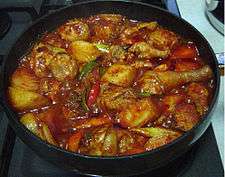
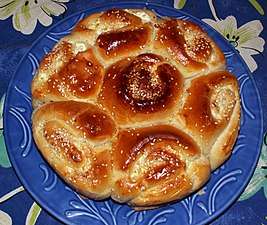



.svg.png)